Zaha Hadid, the world-renowned Iraqi architect, died yesterday in a hospital in Miami aged 65 years. Her company said in a statement yesterday that Zaha “died suddenly in Miami this morning” and that “she suffered from a heart attack” at a hospital where she had been receiving treatment for bronchitis which she had contracted earlier this week.
Zaha Hadid, the daughter of former Minister of Finance Mohammad Hadid (1907 – 1999), was born in 1950 in Baghdad and studied mathematics at the American University of Beirut. She then joined the Architectural Association School of Architecture in London and was awarded a prize by the school in 1977. Later, she became a teacher at the school. Hadid founded her company in 1979 and designed the ski jump on the Bergisel Mountain in Innsbruck, Austria, the Guangzhou Opera House, the Cardiff Bay Opera House and the MAXXI: National Museum of 21st Century Art in Rome. She was also the first woman to win the Pritzker Architecture Prize in 2004.
Hadid is considered a pioneer of Deconstructivist architecture, a school of architecture that is influenced by deconstruction and encourages drastic freedom of form and the open manifestation of complexity in a building rather than strict attention to functional concerns and conventional design elements. The leading pioneers of Deconstructivist architecture include Daniel Libeskind, Peter Eisenman, Rem Koolhaas and Bernard Tschumi.
Hadid did not conduct many interviews with the press and chose Asharq Al-Awsat to be the first Arabic newspaper to interview her in 2008. This was followed by two more interviews; the last was in February 2016 and touched on her career as an architect and her desire to work in Arab countries. She said that the main difficulties that she encountered in her career were related to the fact that she was a woman and an Arab.
During her interviews with Asharq Al-Awsat, the innovative architect of Iraqi origin expressed a desire for her work to be appreciated in the Arab world in the same way that it is in the west. Her desire was fulfilled to a certain extent in the past few years.
